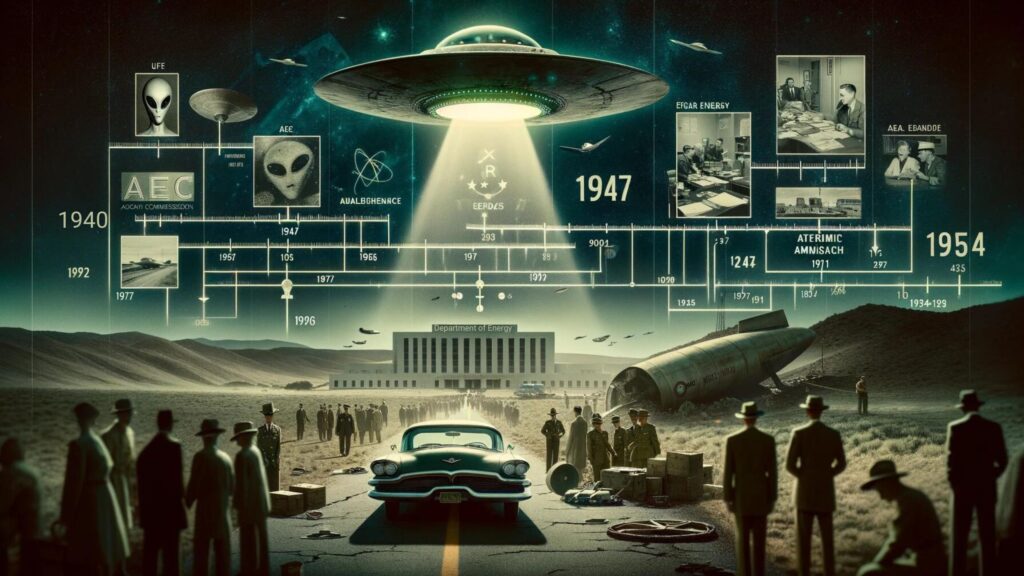A Deep Dive into Edward J. Ruppelt’s “The Report on Unidentified Flying Objects” and Luis Elizondo’s “Imminent”
In the vast expanse of ufology literature, two books stand out as beacons of insight, separated by nearly seven decades yet united in their quest for truth. Edward J. Ruppelt’s groundbreaking 1956 work, “The Report on Unidentified Flying Objects,” and Luis Elizondo’s recent 2023 publication, “Imminent,” offer unique perspectives on one of humanity’s most enduring mysteries. Let’s examine these influential texts and uncover the threads that connect them across time.
The Pioneering Voice: Edward J. Ruppelt

Edward J. Ruppelt, a U.S. Air Force officer, led Project Blue Book from 1951 to 1953. This official UFO investigation program shaped his understanding of the phenomenon and inspired his book. Ruppelt’s work is considered a cornerstone in ufology, providing an insider’s view of early government UFO investigations.
Key Aspects of Ruppelt’s “The Report on Unidentified Flying Objects“:
- First-hand accounts: Ruppelt shared personal experiences from his time leading Project Blue Book, offering readers unprecedented access to official UFO investigations.
- Credible witnesses: The book highlighted cases involving military personnel, pilots, and other trustworthy observers, lending weight to UFO reports.
- Scientific approach: Ruppelt emphasized the need for rigorous, unbiased investigation of UFO sightings, setting a standard for future research.
- Historical context: The author provided valuable insights into the early days of the UFO phenomenon, including the famous 1947 Kenneth Arnold sighting and the Roswell incident.
- Government involvement: Ruppelt detailed the U.S. government’s evolving stance on UFOs, from initial skepticism to serious inquiry.
As an Amazon Associate, I earn from qualifying purchases that help keep this content free.
The Modern Whistleblower: Luis Elizondo

Fast forward to 2023, and we find Luis Elizondo, former director of the Advanced Aerospace Threat Identification Program (AATIP), sharing his experiences in “Imminent.” Elizondo’s book builds on Ruppelt’s foundation while incorporating recent developments in UFO research and government disclosure.
Key Aspects of Elizondo’s “Imminent“:
- Advanced technology: Elizondo discusses encounters with objects displaying capabilities far beyond known human technology, echoing some of Ruppelt’s earlier observations.
- Government secrecy: The author sheds light on ongoing government efforts to study UFOs, revealing a continuity of interest since Ruppelt’s era.
- Threat assessment: Elizondo frames the UFO phenomenon as a potential national security concern, a perspective that has gained traction in recent years.
- Data analysis: The book examines UFO incidents using modern sensor technology and data processing techniques unavailable in Ruppelt’s time.
- Disclosure movement: Elizondo details his role in pushing for greater government transparency regarding UFOs, a process that has accelerated since 2017.
Bridging the Gap: Common Themes and Evolutionary Insights

Despite the decades separating them, Ruppelt and Elizondo’s works share striking similarities while also highlighting the evolution of UFO research. Let’s examine some key areas where these books intersect and diverge:
1. Credibility of Witnesses
Ruppelt: Focused on military and aviation professionals as primary witnesses. He wrote, “The Air Force had developed a system of evaluating the reliability of UFO observers… Many people reporting UFOs were of exceptional caliber.”
Elizondo: Expands on this foundation, incorporating modern sensor data to corroborate witness accounts. He notes, “We now have multiple sensor platforms confirming what human observers have reported for decades.”
2. Government Involvement
Ruppelt: Detailed early U.S. government UFO programs, writing, “Project Blue Book was the latest in a series of official USAF investigations of UFOs dating back to 1947.”
Elizondo: Reveals the existence of more recent programs like AATIP, stating, “AATIP was just the tip of the iceberg. There are other programs that remain classified.”
3. Technological Capabilities
Ruppelt: Described objects performing maneuvers beyond 1950s aviation capabilities. He recounted a witness statement: “It was going faster than anything I’ve ever seen.”
Elizondo: Discusses objects demonstrating “five observables,” including hypersonic velocities and anti-gravity lift. He writes, “These objects are displaying technological capabilities that defy our current understanding of physics.”
4. Scientific Approach
Ruppelt: Advocated for serious scientific study of UFOs. He argued, “Only by thorough, unbiased study can we hope to determine what these objects are.”
Elizondo: Pushes for continued scientific investigation using advanced technology. He asserts, “We have the tools and expertise to study this phenomenon rigorously. We just need the will and resources to do so.”
5. Public Perception
Ruppelt: Noted public fascination and media sensationalism surrounding UFOs. He observed, “In the summer of 1952… you could walk up to almost anyone and say, ‘Did you read about the flying saucers?’ and they’d know you were talking about the Washington, D.C., sightings.”
Elizondo: Discusses the changing public and media attitude towards UFOs. He writes, “We’re seeing a shift from ridicule to serious inquiry. Major news outlets are now covering this topic with the gravity it deserves.”
The Evolution of UFO Research: From Ruppelt to Elizondo
The progression from Ruppelt’s era to Elizondo’s reveals fascinating developments in UFO research:
- Technological advancements: While Ruppelt relied primarily on eyewitness accounts and limited radar data, Elizondo has access to multi-sensor data, including infrared and electro-optical systems.
- Government acknowledgment: Ruppelt operated in an environment of official denial, while Elizondo has witnessed a gradual shift towards government acknowledgment of UFOs as a legitimate phenomenon.
- Global perspective: Ruppelt’s work focused mainly on U.S. sightings, whereas Elizondo discusses UFO incidents worldwide, highlighting the global nature of the phenomenon.
- Interdimensional hypotheses: While Ruppelt mainly considered extraterrestrial explanations, Elizondo explores more exotic possibilities, including interdimensional origins for UFOs.
- Disclosure efforts: Ruppelt operated under strict secrecy, but Elizondo has been at the forefront of efforts to declassify UFO information and inform the public.
Case Studies: Connecting Past and Present
Both authors provide compelling case studies that demonstrate the consistency of UFO phenomena over time:
Ruppelt’s 1952 Washington, D.C. Incident:
Ruppelt wrote about the famous 1952 Washington, D.C. UFO incident, where objects were tracked on radar and visually observed over the nation’s capital. He stated, “When radars at three different locations picked up the targets, and jets were scrambled to intercept them, we knew we had something significant on our hands.”
Elizondo’s Nimitz Encounter:
Elizondo discusses the 2004 USS Nimitz encounter, where Navy pilots observed and engaged with an unidentified object displaying extraordinary capabilities. He notes, “The Nimitz incident is a game-changer. We have highly trained observers, radar data, and electro-optical footage, all confirming the presence of something truly anomalous.”
These cases, separated by over 50 years, show remarkably similar characteristics: multiple expert witnesses, radar confirmation, and objects displaying flight capabilities beyond known technology.
The Impact on Ufology and Beyond

The contributions of Ruppelt and Elizondo have significantly shaped the field of ufology and public perception of UFOs:
- Scientific legitimacy: Both authors have pushed for serious, scientific examination of UFOs, helping to move the subject from the fringes to mainstream discussion.
- Government transparency: Ruppelt’s book offered an early glimpse into official UFO investigations, while Elizondo’s work has been instrumental in recent government disclosures.
- Witness credibility: By highlighting cases involving military and aviation professionals, both authors have bolstered the credibility of UFO reports.
- Technological implications: The advanced capabilities described in both books have sparked interest in potential technological breakthroughs inspired by UFO research.
- Cultural impact: These works have influenced popular culture, from sci-fi literature and films to documentaries and news coverage.
Looking to the Future: The Next Chapter in UFO Research
As we consider the legacy of Ruppelt and Elizondo’s work, several questions emerge about the future of UFO research:
- Will we see full government disclosure of UFO-related information in the coming years?
- How might advances in artificial intelligence and quantum computing aid in analyzing UFO data?
- Could private space exploration initiatives lead to new UFO encounters or discoveries?
- What role will citizen scientists and crowd-sourced data play in future UFO investigations?
- How might contact with non-human intelligence, if confirmed, reshape our understanding of reality and our place in the cosmos?
Conclusion: A Continuum of Discovery
Edward J. Ruppelt’s “The Report on Unidentified Flying Objects” and Luis Elizondo’s “Imminent” bookend nearly 70 years of UFO research. While much has changed in the intervening decades, the core mystery remains tantalizingly unsolved.
Ruppelt laid the groundwork for serious UFO investigation, challenging both blanket skepticism and uncritical belief. Elizondo has built upon this foundation, leveraging advanced technology and pushing for greater transparency in an era of renewed interest in the phenomenon.
As we stand on the brink of potentially paradigm-shifting discoveries, these two books serve as vital guides, reminding us of how far we’ve come in our understanding of UFOs while highlighting how much remains unknown. They challenge us to keep questioning, investigating, and remaining open to possibilities that may reshape our view of the universe and our place within it.
The journey that Ruppelt began and Elizondo continues is far from over. As we look to the skies and ponder the mysteries they hold, we can be certain that the next chapter in this cosmic story will be just as fascinating as the last.
